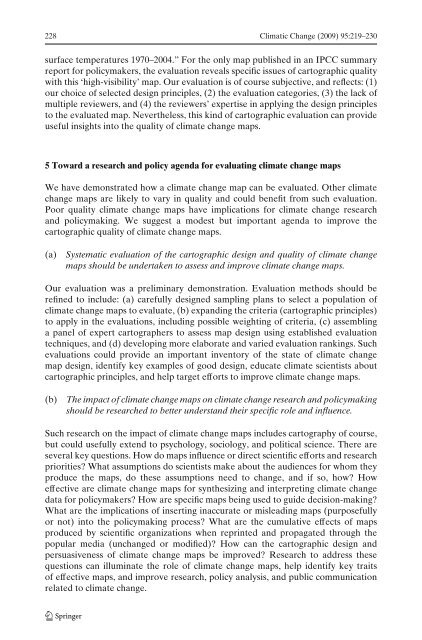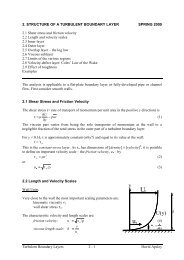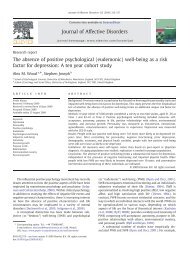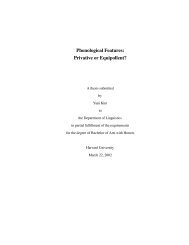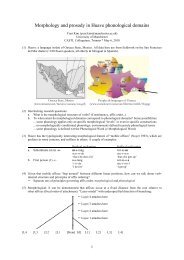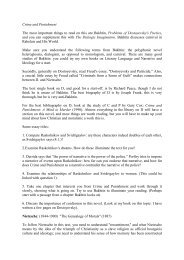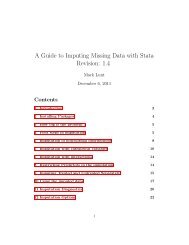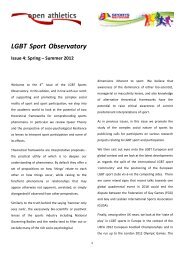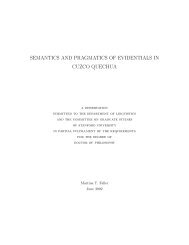Cartographic design and the quality of climate change maps
Cartographic design and the quality of climate change maps
Cartographic design and the quality of climate change maps
Create successful ePaper yourself
Turn your PDF publications into a flip-book with our unique Google optimized e-Paper software.
228 Climatic Change (2009) 95:219–230<br />
surface temperatures 1970–2004.” For <strong>the</strong> only map published in an IPCC summary<br />
report for policymakers, <strong>the</strong> evaluation reveals specific issues <strong>of</strong> cartographic <strong>quality</strong><br />
with this ‘high-visibility’ map. Our evaluation is <strong>of</strong> course subjective, <strong>and</strong> reflects: (1)<br />
our choice <strong>of</strong> selected <strong>design</strong> principles, (2) <strong>the</strong> evaluation categories, (3) <strong>the</strong> lack <strong>of</strong><br />
multiple reviewers, <strong>and</strong> (4) <strong>the</strong> reviewers’ expertise in applying <strong>the</strong> <strong>design</strong> principles<br />
to <strong>the</strong> evaluated map. Never<strong>the</strong>less, this kind <strong>of</strong> cartographic evaluation can provide<br />
useful insights into <strong>the</strong> <strong>quality</strong> <strong>of</strong> <strong>climate</strong> <strong>change</strong> <strong>maps</strong>.<br />
5 Toward a research <strong>and</strong> policy agenda for evaluating <strong>climate</strong> <strong>change</strong> <strong>maps</strong><br />
We have demonstrated how a <strong>climate</strong> <strong>change</strong> map can be evaluated. O<strong>the</strong>r <strong>climate</strong><br />
<strong>change</strong> <strong>maps</strong> are likely to vary in <strong>quality</strong> <strong>and</strong> could benefit from such evaluation.<br />
Poor <strong>quality</strong> <strong>climate</strong> <strong>change</strong> <strong>maps</strong> have implications for <strong>climate</strong> <strong>change</strong> research<br />
<strong>and</strong> policymaking. We suggest a modest but important agenda to improve <strong>the</strong><br />
cartographic <strong>quality</strong> <strong>of</strong> <strong>climate</strong> <strong>change</strong> <strong>maps</strong>.<br />
(a) Systematic evaluation <strong>of</strong> <strong>the</strong> cartographic <strong>design</strong> <strong>and</strong> <strong>quality</strong> <strong>of</strong> <strong>climate</strong> <strong>change</strong><br />
<strong>maps</strong> should be undertaken to assess <strong>and</strong> improve <strong>climate</strong> <strong>change</strong> <strong>maps</strong>.<br />
Our evaluation was a preliminary demonstration. Evaluation methods should be<br />
refined to include: (a) carefully <strong>design</strong>ed sampling plans to select a population <strong>of</strong><br />
<strong>climate</strong> <strong>change</strong> <strong>maps</strong> to evaluate, (b) exp<strong>and</strong>ing <strong>the</strong> criteria (cartographic principles)<br />
to apply in <strong>the</strong> evaluations, including possible weighting <strong>of</strong> criteria, (c) assembling<br />
a panel <strong>of</strong> expert cartographers to assess map <strong>design</strong> using established evaluation<br />
techniques, <strong>and</strong> (d) developing more elaborate <strong>and</strong> varied evaluation rankings. Such<br />
evaluations could provide an important inventory <strong>of</strong> <strong>the</strong> state <strong>of</strong> <strong>climate</strong> <strong>change</strong><br />
map <strong>design</strong>, identify key examples <strong>of</strong> good <strong>design</strong>, educate <strong>climate</strong> scientists about<br />
cartographic principles, <strong>and</strong> help target efforts to improve <strong>climate</strong> <strong>change</strong> <strong>maps</strong>.<br />
(b) The impact <strong>of</strong> <strong>climate</strong> <strong>change</strong> <strong>maps</strong> on <strong>climate</strong> <strong>change</strong> research <strong>and</strong> policymaking<br />
should be researched to better underst<strong>and</strong> <strong>the</strong>ir specific role <strong>and</strong> influence.<br />
Such research on <strong>the</strong> impact <strong>of</strong> <strong>climate</strong> <strong>change</strong> <strong>maps</strong> includes cartography <strong>of</strong> course,<br />
but could usefully extend to psychology, sociology, <strong>and</strong> political science. There are<br />
several key questions. How do <strong>maps</strong> influence or direct scientific efforts <strong>and</strong> research<br />
priorities? What assumptions do scientists make about <strong>the</strong> audiences for whom <strong>the</strong>y<br />
produce <strong>the</strong> <strong>maps</strong>, do <strong>the</strong>se assumptions need to <strong>change</strong>, <strong>and</strong> if so, how? How<br />
effective are <strong>climate</strong> <strong>change</strong> <strong>maps</strong> for syn<strong>the</strong>sizing <strong>and</strong> interpreting <strong>climate</strong> <strong>change</strong><br />
data for policymakers? How are specific <strong>maps</strong> being used to guide decision-making?<br />
What are <strong>the</strong> implications <strong>of</strong> inserting inaccurate or misleading <strong>maps</strong> (purposefully<br />
or not) into <strong>the</strong> policymaking process? What are <strong>the</strong> cumulative effects <strong>of</strong> <strong>maps</strong><br />
produced by scientific organizations when reprinted <strong>and</strong> propagated through <strong>the</strong><br />
popular media (un<strong>change</strong>d or modified)? How can <strong>the</strong> cartographic <strong>design</strong> <strong>and</strong><br />
persuasiveness <strong>of</strong> <strong>climate</strong> <strong>change</strong> <strong>maps</strong> be improved? Research to address <strong>the</strong>se<br />
questions can illuminate <strong>the</strong> role <strong>of</strong> <strong>climate</strong> <strong>change</strong> <strong>maps</strong>, help identify key traits<br />
<strong>of</strong> effective <strong>maps</strong>, <strong>and</strong> improve research, policy analysis, <strong>and</strong> public communication<br />
related to <strong>climate</strong> <strong>change</strong>.


